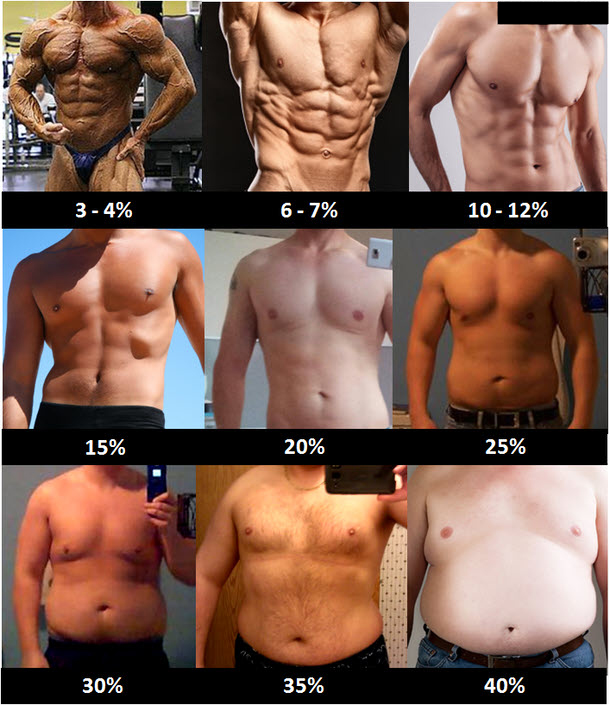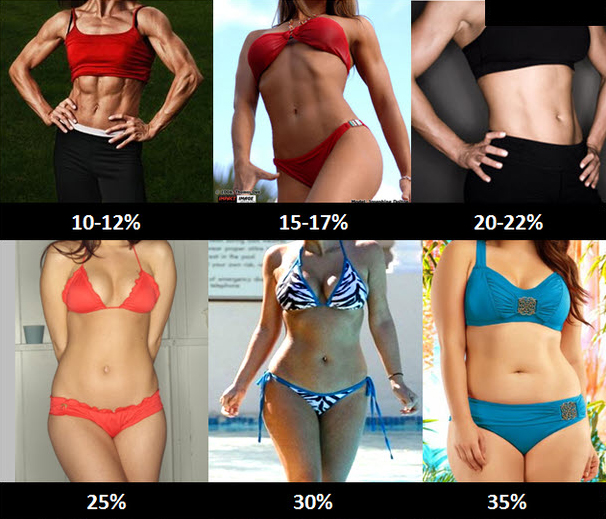The percentage of body fat is gaining more popularity as an effective marker of health and fitness than the BMI Index ( body mass index ).
I hope this article helps you differentiate your fat percentage through visual representations of various people.
Percentage of fat
To better understand the descriptions in this article and how the photos were chosen, here are some body fat percentage terms and basics that are helpful to learn:
- Body Fat Percentage – is the amount of body fat (lb or kg) divided by the total body weight. For example, a 180-pound man with 30 pounds of body fat has a body fat percentage of 16% (30/180).
- Body Fat Distribution – We all have different body fat distributions, or how fat is distributed throughout our bodies. For example, some women may have very little body fat in their abs, but a lot of fat in their thighs and triceps, while others will have the opposite. The same is true for men, but most men have stomach fat. I did my best to show the images that highlight the stomach region for men and the hips / thighs / stomach region for women.
- Body Types – We all have different body types, so two people with different bodies with the same percentage of body fat will never look the same. An example: a runway model may have the same percentage of body fat as an athletic or bodybuilder woman and yet they are nothing alike.
- Age – The images in this post assume ages around 25-35 years old. Most body fat measuring devices will reflect higher body fat levels as age increases. For example, a 20-year-old man and a 50-year-old man may have the same body measurement of subcutaneous fat (fat under the skin), but the 20-year-old can reach 15% and that of 50 years old, it will be at 20%. As we age, the fat around the organs (visceral) and within the muscle (intramuscular) tends to increase and most formulas take this into account.
- Vascularity – This is the appearance of veins in different areas of the body as body fat decreases.


Analyzing the percentages
Percentage of body fat 3-4%
Bodybuilders can go as low as 4.3% body fat in preparation for bodybuilding competitions. This level of body fat is characterized by intense vascularity, so veins are visible in almost every muscle in the body. There is a clear separation between the muscles and visible stretch marks in almost all muscles. In the buttocks (I will not put an image) they even have stretch marks, some vascularity, with little fat. If your glutes have no body fat, you have very little body fat! Essential fat for a man is around 2%, which is the basic amount of fat a man needs for the body to function (fat protects internal organs in the chest and abdomen). Women cannot reach this fat percentage.
Percentage of body fat 6-7%
About 6-7% of body fat for a man is slightly less extreme than competitive bodybuilders, but it is still a level that is not sustainable for most men. Around this level, or a little less, your face becomes skinny or puffy, and your family begins to worry about you. This level of body fat is what is achieved by many male fitness models when doing photoshoots, it is characterized by muscle definition in all muscles and clear vascularization in most muscles, including the arms, legs, and even the ABS. Vascularity over the abdominal muscles is a sign of too little body fat. The clear separation of the muscles as well. Women cannot reach this fat percentage.
Percentage of body fat 10-12%
This is a sustainable level for most men where you should be able to see abs, but they are probably not defined as in the 6-7% body fat range. This range of body fat is the classic beach body look that most men want and many women love. Although not very defined, there is no separation between the muscles, some muscle stretch marks potentially on the shoulders or arms, but the fibers or stretch marks are not shown in every muscle. Vascularity is normally limited to the arms and possibly the legs. This is the lowest level of fat a woman can reach.
Percentage of body fat 15%
The 15% body fat level is generally the “slim and fit” category. The contours of the muscles can be seen, but there is no clear separation between them. Vascularity is generally a bit more limited as are the muscle fibers or striations, which are normally covered by a thin layer of fat. The overall shape is still there, which can create an aesthetic appearance despite less muscle definition.
Percentage of body fat 20%
The separation between the muscles begins to blur, with almost no vascularity or stretch marks, usually there is a small bag of fat in the stomach, the look is “smooth”, and not very round.
Percentage of body fat 25%
There is little or no separation of the muscles, without vascularization, or muscle stretch marks, the waist begins to increase substantially. At this rate you can have a little neck fat, but it doesn’t seem like you have 25% body fat with your clothes on. More than 25% of body fat for a man is considered overweight, and a 40-inch waist is considered abdominal obesity.
Percentage of body fat 30%
There is more fat throughout the body at the 30% level, including the waist, back, thighs and calves. The waist appears larger relative to the hips and the stomach is likely to protrude noticeably above the waist. There is no muscle separation.

Percentage of body fat 35%
As more fat is gained, most of this fat is channeled right into the stomach (the rubbers). The 35% level is characterized by a significant bulge of stomach fat across the waistline. This is the brewer’s gut. Waist circumference can be over 40 inches for a person with 35% body fat .
Percentage of body fat 40%
As at the 35% level, fat accumulates in the stomach and waist region, so waist sizes can approach 45 inches or more. At this level, basic daily activities like climbing stairs or bending down to pick something up are increasingly difficult. This level of body fat is approaching morbid obesity. An obese person usually has more than 40% body fat …
